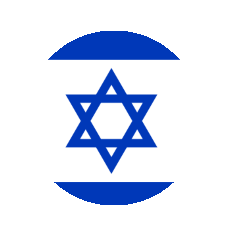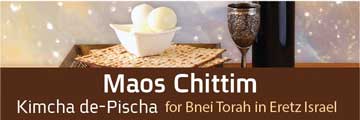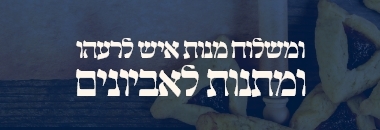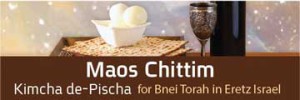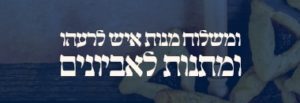Halacha Talk
Children and the Mitzvos of Purim
In general, the halacha is that although girls below the age of twelve and boys below the age of thirteen are exempt from observing mitzvos (Mishnah Avos 5:21; Niddah 52a), there is a Rabbinic obligation on the father to train his children to perform mitzvos (Chagigah 4a). (This follows the majority of poskim. There are those who maintain that the mother is obligated to train her children as well (Mishnah Berurah 343:2.) Not only does this responsibility exist with regards to mitzvos mide’oraisa such as shofar, succah and arba minim, but it also applies to mitzvos miderabbanan. Included in this latter category are all of the mitzvos of Purim: Kri’as megillah, mishlo’ach manos, matanos la’evyonim and seudas Purim (Pri Megadim 695, Eishel Avraham 14).
The obligation of chinuch begins at “gil chinuch” – the “age of training.” Generally speaking, for most mitzvos this is when the child is old enough to understand the mitzvah he is performing. This being the case, each child will have his own gil chinuch for each mitzvah (Succah 42a; Magen Avraham, Shulchan Aruch 343:3).
READING THE MEGILLAH
The Shulchan Aruch (Orach Chaim 689:1) writes that everyone, including men and women, is obligated in the mitzvah of reading the megillah, and “one should train children to read it.” Although the Mechaber specifies reading the megillah, the child, like anyone else, fulfills the mitzvah by listening to the megillah reading (Biur Halacha, s.v. es haketanim likrosa).
This halacha that one must train children to read the megillah creates a difficulty with a subsequent halacha. The Mechaber later writes that it is “a proper custom to bring children to hear the megillah reading” (689:6). If one must train his child to read or listen to the megillah, then why is it merely a “proper custom” to bring children to hear the reading?
The Chofetz Chaim explains that in order to fulfill the obligation to train one’s child, it is sufficient to read the megillah for him at home. However, in order to publicize the Purim miracle, it is “a proper custom” to bring the children to shul in order to hear the megillah publicly (Biur Halacha 689, s.v. minhag tov l’havi).
In order to publicize the miracle and keep the children’s interest in the leining, there is a custom for the congregation to read four passukim out loud. These passukim are: “Ish Yehudi…” (2:5), “u’Mordechai yatza…” (8:15), “La’Yehudim…” (8:16), “Ki Mordechai… (10:3). These four passukim were chosen because they signify the beginning and the end of the nes (Levush 689:3). When the child notices that these four passukim are given special significance, this encourages him to ask for the reason, thereby giving the parent the opportunity to relate the miracles that Hashem performed (Eliyahu Rabbah 689:10).
The mitzvah of chinuch dictates that one should see to it that his child hears the megillah leining, and this should be the reason why the child comes to shul. However, there is no mitzvah of chinuch or otherwise to bring a child to shul in order to “klop Haman.” Additionally, if the child is not old enough to sit quietly throughout the reading and he will disturb the other participants, that child has not reached gil chinuch and it is best if he stays at home (Magen Avraham 689:11; Mishnah Berurah 17-18).
WHO IS WATCHING THE BABY?
The contemporary poskim discuss the following scenario: A family with two children, ages eleven and two. It is Purim night and time to go hear the megillah. The two year old cannot be brought to shul since he will disturb the reading. Where someone will come later to read the megillah for the one who cannot go to shul, who should remain home to watch the toddler – the mother or her eleven year old son?
Some maintain that the eleven year old should go to shul while his mother remains home. In order to understand this, we must point out that there are actually two separate mitzvos at work here. There is the mitzvah of hearing the megillah and there is an additional mitzvah of “b’rov am hadras melech” – that it is preferable to perform a mitzvah along with a group, in this case, to hear the leining in shul. With regards to our question, the mother has a greater chiyuv to hear the megillah than her eleven-year-old child. This is because, as an adult, she has a mitzvah miderabbanan to hear the megillah, while a child that has reached gil chinuch does not. (Although technically speaking, such a child is obligated miderabbanan to hear the megillah because of chinuch, it is a lower-level chiyuv than an adult’s. An adult has a first-level responsibility to perform the mitzvah derabbanan, while a child has a mitzvah derabbanan to perform another mitzvah derabbanan.)
On the other hand, when it comes to the mitzvah of “b’rov am hadras melech,” the eleven-year-old boy has a greater chiyuv than his mother. The reason is that since he will be obligated to perform mitzvos “b’rov am” when he becomes an adult, he is also obligated now because of chinuch reasons. However, a woman is exempt from the mitzvah of b’rov am hadras melech. This is because of the concept of “kol kevudah bas melech penimah,” that the most honorable place for a bas melech, a Jewish woman, is indoors, away from the public eye (Shu”t Chelkas Yaakov, vol. III, #144).
Others contend that the mother should go to shul and the eleven-year-old boy should baby-sit his younger sibling. The reason for this is that there are opinions among the poskim that lechatchilah, a woman should not read the megillah herself, rather she should hear it from a man. (See Rema 689:2 and Magen Avraham 6 in the name of Medrash HaNe’elam.) Regarding a child, on the other hand, we quoted the Shulchan Aruch earlier as saying that a child should be trained to read it. Therefore, a woman has a greater chiyuv to hear the megillah than a child. Since this is true, it is the woman who should go hear the megillah leining in shul, while the eleven year old stays home (Shu”t Mishnah Halachos, vol. IV, #82).
RELYING ON OTHERS
Regarding the mitzvos of Mishloach Manos and Matanos l’Evyonim we will broaden our discussion to include other household members aside from children under the age of bar or bas mitzvah. The reason for this is because the halachic principles are common to both groups. Let us discuss the following household members: 1) The head of the household (if not the man, then the woman); 2) the wife; 3) household members over the age of bar or bas mitzvah who earn their own money; 4) those that do not; and 5) minor children.
The head of the household, whether a man or a woman, is obligated in the mitzvos of Mishloach Manos and Matanos l’Evyonim (Shulchan Aruch and Rema 695:4). If the husband is the head of the house, there is a disagreement among the poskim whether the wife is obligated in these mitzvos. Some maintain that she is because women were included in the miraculous salvation. Others hold that anyone who is dependent on someone else for his or her sustenance is exempt from these mitzvos. Generally speaking, most wives are included in this category, even if they are breadwinners. The reason for this is beyond the scope of this article. However, it is actually a moot point, since most of the poskim anyway contend that every woman should be stringent and perform these mitzvos (Magen Avraham 695:12)
The third type of household member, those over the age of bar or bas mitzvah who earn their own money, are certainly obligated in these mitzvos. Since the money they have is their own, there is no reason to exempt them and they must use these funds for the mitzvos (Shu”t Kinyan Torah, vol. I, #132).
People of the fourth category, adult household members who do not earn their own money, are very similar to the second category, wives. On the one hand, they are adults and chayev b’mitzvos, but at the same time they have nothing of their own and how can we obligate them? Here also there is a disagreement among the poskim, but it is proper that they be stringent and perform these mitzvos regardless (Magen Avraham ibid; Chaye Adam 155:33).
SUPPLYING THE GOODS
Before turning to the last category, let us briefly discuss how one should assist his wife and adult household members in performing their obligations. As we mentioned, lechatchilah, a wife and adult household members should send Mishloach Manos and Matanos l’Evyonim. The question is, how should they go about this? Technically speaking, according to halacha, most items in the house belong to the husband. May one take foodstuffs and money from the head of the house in order to perform the mitzvos?
Some maintain that although the head of the house does not mind if food and money are taken for these purposes, nevertheless, before sending the Mishloach Manos or Matanos l’Evyonim, one should lechatchilah perform a kinyan, an act of acquisition on the item he wishes to use. This is accomplished by raising it a height of three tefachim. If one sent the manos or the matanos without having done so, he has fulfilled his obligation (Rav Chaim Kanievsky, quoted in Kitzer Dinei Purim pg. 40 #1 and Rav Yosef Shalom Elyashiv, quoted in Toras HaMoadim pg. 21 #8).
Others contend that unlike the mitzvah of lulav where there is a concept of “lachem” – that the item must be owned by the one performing the mitzvah, there is no such requirement with Mishloach Manos and Matanos l’Evyonim. Since the head of the house does not mind, the household members may merely take what they need in order to perform the mitzvos (Rav Shlomo Zalman Auerbach, quoted in Sefer Yismach Yisrael, pg. 87, footnote #38; Shu”t Shevet HaLevi, vol. IX, #147.1).
MINORS AND MISHLOACH MANOS
The last category of household members left to discuss is that of children under the age of bar or bas mitzvah. Although it would seem that they should be no different from the previous category of those who are over bar or bas mitzvah and have no money of their own, there is a very crucial distinction. When it comes to children over the age of bar or bas mitzvah, they are basically “on their own” vis-à-vis mitzvah observance. Aside from the concept of “tochacha,” where one is commanded to rebuke any Jew who is not performing mitzvos, the father has no halachic responsibility to see to it that they perform the mitzvos. However, when it comes to children under bar or bas mitzvah, the father has a mitzvah derabbanan to train them to perform mitzvos. Therefore, a father must see to it that his minor children send Mishloach Manos and give Matanos l’Evyonim (Pri Megadim 695, Eishel Avraham 14).
This produces a halachic oddity. According to some poskim, a father does not have to provide his adult children, who are chayev in mitzvos, with the wherewithal to perform them. On the other hand, for his minor children, who are technically exempt from the mitzvos, he does.
SENDING MISHLOACH MANOS
The customary method of performing mitzvas Mishloach Manos is to send the food packages with a shaliach, an agent. This is done in order to fulfill the literal reading of the passuk, “u’mishloach manos” – “and sending portions.” However, the poskim discuss whether sending them with an agent is required or simply a custom (Mishnah Berurah 695:18). The consensus of the poskim is that it is preferable, but not required to use an agent (Hilchos Chag b’Chag 13:8).
SHELICHUS AND MINORS
Included in the rules of shlichus is that a minor does not have the capability to appoint someone as his shaliach, nor may he function as the shaliach for someone else. For example, one may not appoint a minor as an agent to separate terumah and ma’aser from his produce.
The question discussed regarding Mishloach Manos is whether or not one may send a child under the age of bar or bas mitzvah to deliver the food package. As we mentioned, according to some opinions, one fulfills the mitzvah of Mishloach Manos by sending food packages to a friend or neighbor. If so, perhaps one may not appoint a child to do this task, since a child cannot become a shaliach.
However, the consensus of all the poskim is that one may appoint a child to deliver Mishloach Manos. If the mitzvah of Mishloach Manos would have obligated a person to actually give food packages himself, then it could be argued that one’s agent would have to meet all the prerequisites of shlichus, thereby disqualifying minors. But since the mitzvah of Mishloach Manos is to send packages through a third party, it makes no difference how it is sent (Chidushei Chasam Sofer, Gitin 21b; Mekor HaChaim [Chavos Ya’ir] end of chap. 692; Da’as Torah 695).
THE PURIM SEUDAH
There is a mitzvah to eat a festive meal on Purim in order to commemorate the miracle that took place. This applies to both men and women (Shulchan Aruch 696:7; Pri Megadim 695, Eishel Avraham 14; Mishnah Berurah 695:4).
Is one obligated to train children in this mitzvah?
Based on a comment of the Vilna Gaon on a passuk in Esther, some contend that perhaps not. The passuk says (9:28), “…and these days of Purim shall not be revoked from amidst the Jews, and their memory shall not cease from their seed.” The Gaon is troubled by two points: 1) What is the difference between the phrase “these days of Purim,” and the phrase, “their memory”? 2) Additionally, why in the first part of the quote does the passuk refer to “the Jews,” while the later part speaks of “their seed”?
To reconcile these difficulties he explains that, “these days of Purim” refer specifically to the festive Purim meal, while “their memory” hints to the reading of the megillah. Also, the phrase “the Jews” refers to adults, whereas “their seed” refers to children under the age of bar or bas mitzvah. Therefore, the passuk is to be understood as follows: “And these days of Purim,” i.e., simchas Purim and seudas Purim, “shall not be revoked from amidst the” adult “Jews,” i.e., over the age of bar or bas mitzvah, “and their memory,” the megillah reading,” shall not cease from their seed,” i.e., those who are minors.
This indicates that underage children are only obligated to hear the megillah leining and they do not need to participate in the Purim meal. Rav Moshe Sternbuch (Sefer Moadim u’Zmanim, vol. II, #190 in footnote) explains that a father is only obligated to train his children to perform mitzvos that are action-oriented, e.g., sit in a succah, take a lulav, eat matzah. However, regarding mitzvos that are dependent on thoughts or emotions such as simchas Purim, remembering the miracles and thanking Hashem for His salvation, a father does not have to train his child. This is because a child does not have the emotional maturity required for such mitzvos.
Other poskim do not differentiate between action-oriented and thought-related mitzvos and maintain that a father must train his children in the mitzvah of Purim seudah just as he must train them to do other mitzvos. This is especially true, since “they were also included in the miracle” (Sefer Yismach Yisrael 28:8).
COSTUMES
A common type of Purim costume, especially for children, is to dress girls as boys and boys as girls, either partially or completely. The question that needs to be discussed is whether this is permitted.
This is not a new issue, but rather something that was debated by the Rishonim, as this custom existed even then. One Rishon states that “Gedolim and Chasidei olam” saw “their sons, daughters, sons-in-law and daughters-in-law… change their clothing from men’s clothes to women’s and vice versa. And if there would have been the slightest sin, chalilah that they should be silent and not protest” (Shu”t Mahari Mintz, end of #15).
The Torah warns (Devarim 22:5), “A man’s attire shall not be on a woman, nor may a man wear a woman’s garment.” Although this would indicate that one may never wear any garment belonging to the opposite gender, some Rishonim maintain that it all depends on one’s intent. It is only forbidden if one does it in order to sit among members of the opposite gender or if one’s intention is to commit a sin. Being that when one dresses this way on Purim his intention is for Simchas Purim, it is permitted (ibid.).
Another reason to be lenient is based on what was an accepted practice during the time of the Rishonim. During that era they had an interesting method of entertaining the chasan and kallah at their wedding: young men riding horses would have a jousting match! The halacha is that if they tore each other’s clothing while doing so, they are exempt from paying damages, since they were doing so because of simchas chasan. Based on this, the Rishonim maintain that if someone damages someone else’s property due to simchas Purim, he is likewise exempt.
With regards to wearing clothing of the opposite gender, some Rishonim rule leniently with the contention that if we “permit” one to transgress the Torah prohibition of stealing because of simchas chasan or simchas Purim, i.e., damaging someone’s property, as mentioned previously, we should likewise allow one to be lenient with the prohibition of men wearing women’s clothing.
Other Rishonim however disagree and contend that Simchas Purim is not a sufficient reason to relax prohibitions. (See Darchei Moshe, Orach Chaim 696). The Rema quotes both opinions and concludes that the custom is to follow the lenient opinion. This is also the view of many of the poskim (Levush 696; Mateh Moshe #1014).
However, other Acharonim disagree with the Rema and the basis for the lenient ruling. They quote other Rishonim who forbid the practice of wearing clothing of the opposite gender in order to entertain the chasan and kallah during a chasunah. Thus we see that even for the purposes of simcha one may not be lenient in this prohibition.
Additionally, the fact that one is not liable for damaging someone’s clothing during simchas chasan or simchas Purim is not a reason to permit other prohibitions. When it comes to monetary claims, there is a concept called, “hefker beis din, hefker” – beis din has the authority to declare someone’s property ownerless. Therefore, if someone damages property during simchas chasan, the property owner cannot claim damages because beis din has in effect declared that item ownerless before it was damaged. With regards to other prohibitions however, there are no such dispensation (Bach, Orach Chaim 696, quoting Rabbeinu Eliezer mei’Mitz; Taz, Yoreh De’ah 182:4).
The Mishnah Berurah (696:30) quotes the stringent opinion and writes that one should abolish the custom of wearing clothing of the opposite gender. However, he quotes the ruling of the Pri Megadim that one should not protest upon seeing a person who is otherwise properly attired but he is also wearing one article of clothing of the opposite gender. Yet, he concludes with the words of the Shelah HaKadosh, that one should distance oneself from such things.
There is a disagreement among contemporary poskim whether one may dress a child under the age of bar or bas mitzvah in clothing of the opposite gender. Some maintain that it is forbidden because of the mitzvah of chinuch and one may not put his child in a position where he will transgress an issur (Dinim v’Hanhagos l’Chazon Ish 21:10; Shu”t Yechave Da’at vol.V #50; Shu”t Mishnah Halachos, vol. III #148).
Others contend that since the Rema holds that the minhag follows the lenient opinion, there is no prohibition in dressing children in this manner (Sefer HaKatan v’Hilchosav 34:10).
PURIM AND CHINUCH
What was the situation of the Jews during the time of Mordechai and Ester? They all went to Achashveirosh’s feast. A feast whose purpose was to celebrate the fact that, according to their reckoning, the Jews would no longer leave golus. A feast where the utensils of the Beis HaMikdash were used with impunity. A feast during which Achashveirosh donned the garments of the cohen gadol. Additionally, the Jews of that generation were guilty of idol worship (Megillah 11b-12a), and Haman accused them of “sleeping” in their mitzvah observance (Yalkut Shimoni Ester #1056).
However, during this dark and confusing period there was one household that stood out: the home of Mordechai HaYehudi! He took in his orphaned niece and raised her as his own. He succeeding in training her to such a degree that even after she became the ruler of one hundred and twenty-seven countries, nevertheless she remained faithful to everything Mordechai commanded her to the same degree as when she was in his home. It was through this chinuch that the salvation came to Klal Yisrael (Sefer Divrei Agadah [Rav Yosef Shalom Elyashiv shlit”a] pg. 474).
In this article we discussed the parent’s obligation to train his child in the mitzvos of Purim. However, one must keep in mind that a parent’s role in chinuch goes well beyond the actual mitzvos that the child does. Parents must also see to it that their children keep the “fifth portion of the Shulchan Aruch” – how a Jew must appear and act in public. This is all the more so true on Purim. Chazal tell us that whenever there is a great amount of kedusha, the Yetzer HaRa’s powers also increase. Purim is a day saturated in kedushah. We must be vigilant that our children not only have a Purim that is Samayach, but that they should also have a Purim that is kosher!

